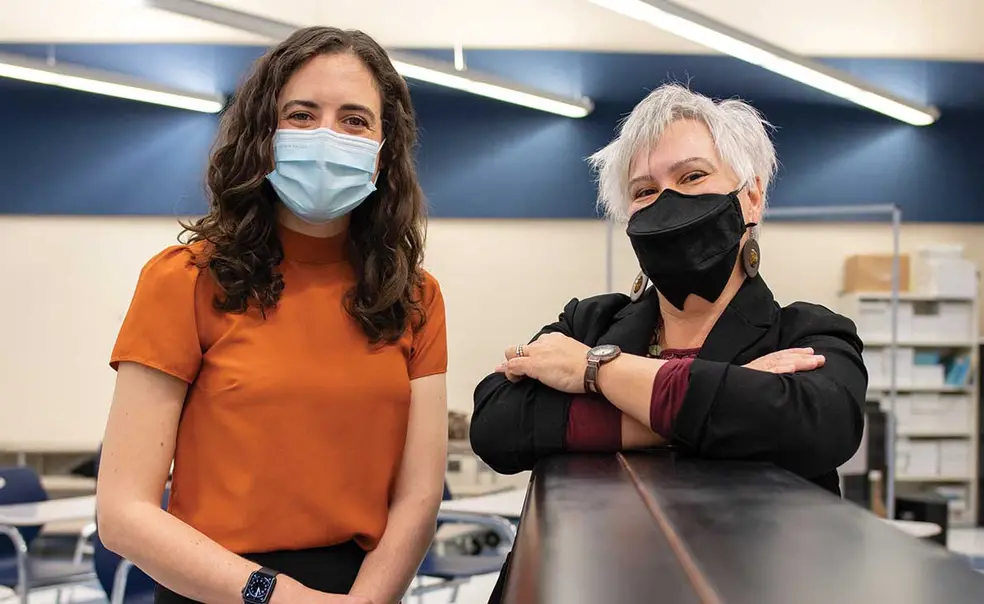Grad Students Hone Teaching Skills at Local Community Colleges
‘If you’re really interested in becoming a leader in higher ed, there is no better place to start than in community colleges’
By her own admission, Sophie Brady, a fifth-year musicology graduate student, did not go to a rigorous high school. Having grown up in a small town in Ohio where most of her peers didn’t attend college, Brady wanted additional support before applying to four-year institutions. So she started taking courses at her local community college while still in high school.
“It was really essential for filling in some of the gaps that my high school education just couldn’t provide,” she said.
A decade later, things came full circle when Brady was accepted into Princeton’s Community College Teaching Partnership, in which University graduate students spend a semester shadowing a faculty member at Mercer County Community College, Camden County College, or Rowan College of South Jersey (RCSJ) before teaching a course of their own.
This academic year, 20 Princeton students are taking part, the largest group since the program was reestablished during the 2016–17 academic year. The late Professor Theodore Rabb *61 conceived a previous iteration in 1974, but over the decades it changed and participation dwindled. In the new version, the Graduate School provides a stipend to students while they shadow community college faculty, and then the community colleges pay the students to teach.
It’s a win-win-win, according to Natalka Pavlovsky *01, an RCSJ professor of music who serves as a faculty mentor. Not only do Princeton students get guidance and real-life teaching experience, but their mentors can discuss teaching methodologies with up-and-coming scholars. And community college students “get fantastic instructors out of it,” Pavlovsky said.
Cathy Carsley *93, who took part when she was at Princeton, has been a faculty member at Montgomery County Community College in Pennsylvania since 2008. She’s glad to see Princeton reviving and expanding the program, especially because there is a perception of a divide in higher education between two- and four-year schools. But Carsley doesn’t want that to deter graduate students.
“If you’re really interested in becoming a leader in higher ed, there is no better place to start than in community colleges because there’s so much opportunity,” Carsley said. She encourages graduate students to “keep an open mind about your career pathways.”
Since the program was reimagined, 35 Princeton students have participated, and of those, 10 have completed their graduate education. All 10 have gone on to be employed within the education sector, including one who teaches at a community college.
For Brady, who shadowed Pavlovsky during the spring 2021 semester before leading her own “Music Appreciation” course for about 20 students last fall, teaching at RCSJ felt different than her previous experiences teaching at Princeton. She realized that community college students often don’t receive the same kind of support as Princeton students.
“I think it made me appreciate how much we take for granted at an institution like Princeton, because there are so many resources for students,” Brady said. “In terms of my own teaching, it’s really helped me to become more aware of that and really think, ‘What do the students need from me in order to thrive?’”
For example, she learned to schedule emails so they would be delivered when students were most likely to read them, usually late at night. That was just one method she used to reach a diverse group of students who often face a different set of challenges, including a lack of financial resources, family obligations, and competing priorities, such as jobs.
Though Brady didn’t anticipate the amount of time and effort involved, she relished her time at RCSJ and found the work meaningful and important. She believes programs like this one are key in allowing Princeton to “give back to the broader community and share resources, because we have graduate students who really want to teach, who love to teach, and we have these opportunities to participate in and get to know members of our community that we might otherwise not meet.”












1 Response
Jim Perry ’57
3 Years AgoIn Praise of Community Colleges
I hope Princetonians will do more than just use community colleges to hone skills for careers elsewhere (On the Campus, April issue). Community colleges are “America’s best bridge to the middle class,” as President Bill Clinton declared in a speech at Princeton, but they are more than that. Community colleges promote full situational awareness for human beings, above and beyond every possible routine and framework, for students who will never hear about it unless we tell them.
Teaching philosophy for 36 years in a community college let me share ideas Princeton gave me with more than 14,000 students of all ages, most of them first-generation college students. It allowed me to publish a book and numerous professional papers, and to become a founding officer of the Community College Humanities Association (conceived at a Princeton Leadership Conference 40 years ago) and an officer of two statewide professional organizations. It gave me mentoring opportunities with outstanding young colleagues. Teaching in a community college allowed me to matter more than I ever dreamed possible. Princeton promised I would love it. She was right.